by Chuck Cravens

The Red Tail mounted in its fixture at the AirCorps Aviation restoration shop with another rare C model, Lope’s Hope 3rd in the background. We are very privileged to have two P-51Cs in the shop at once, truly an unusual sight!
Update
In last month’s Red Tail update we left off with work on the doghouse. That work is progressing and as you will notice, the skin is mostly finished in that area with just the door assembly skins that go on each side to be done.

Randy is marking coolant radiator access skin known as the “wrapper” for drilling.

In the same area, the top skin of the duct for the oil cooler scoop exit door is visible but not pulled up into place.

Randy is double checking the fit of the new radiator “wrapper.”

The coolant radiator access skin is clecoed in place.

Randy is working on the bottom side.

The stiffener is riveted in, the skin is in place temporarily until the radiator is installed, oil cooler exit door duct top skin now in place.
Fuselage Building
The fuselage work still needed before the Merlin arrives consists of several sections.
Building and fitting the scoop to the doghouse is just getting started. The left hand and the lower cowl skin sections need to be replaced, so they are being fabricated. Some of the cowl ribs also still need to be installed and the air induction ducting system that connects to the rear of the cast “smile“ is coming up soon. Naturally there will also be systems installation for the firewall forward area once the engine is here.

Cowl ring and cowling support pieces are ready to go.

Parts are categorized by assembly so they are ready when they will be needed.

Scoop parts are also on the shelf ready for use.

Scoop parts are also on the shelf ready for use.

The oil cooler is in place in the doghouse, ready for that new scoop to be finished.
It is always important to manage the parts inventory so the necessary parts are on hand when needed. Various shelves and bins are used to organize the parts, each one labeled with part numbers and project owner.
Cowl
The left side middle and all lower cowl skin will be replaced and will be fabricated as mentioned above but the stainless exhaust shroud is still serviceable. The engine mounts are still to be installed in this shot.

Cowl skin parts are fitted or reused.

You can see how the right side skin still looks great.


Fabric Covering
People are sometimes surprised that Mustangs and other warbirds have fabric covered control surfaces. Which surfaces are fabric, if any, depends on the type of warbird and sometimes even the model within types. In the case of the various P-51 models, B, C, D and K models had fabric covered rudders. B and C models all originally had fabric covered elevators but early D and K models had a buffeting problem during high speed dives that was attributed to bulging fabric on the elevators.
Consequently in 1944, Technical Order 01-60-100 specified that all new D and K models would have aluminum skinned elevators and all existing D and K’s would be retrofitted. According to what many consider to be the definitive book on Mustangs, Robert Gruenhagen’s Mustang, the Story of the P-51 Fighter, the change began at the Inglewood factory with P-51D-20NA #401, and the first P-51D-25NA which were on the assembly line simultaneously. At the Dallas plant the change occurred beginning with the first P-51K-10NT and P-51D-20NT. With the change to metal elevators, the angle of incidence of the horizontal stabilizer was also changed to one half a degree.
True to its original form coming out of the Dallas factory, the Red Tail retains fabric elevators and rudder.

Mark and Brent are making decisions on the rudder covering.



Brent carefully sticking the fabric down around the position light on the rudder.
Engine Mounting

Sam and Ryan check and inspect parts.

These are engine mount bushing housings ready for vibration isolating Lord mounts to be installed.

A new side cowl former has been installed.

The “smile” is on the Red Tail! The metal plate with the pencil and parts bins on it is used as a datum plane representing the centerline of the crankshaft. It bolts directly to the engine mounts.


For the coming month, we are looking forward to seeing the repaired V1650 in our shop. Tuskegee Airmen will look much more like a Mustang when the Packard Merlin is sitting in the mounts.
